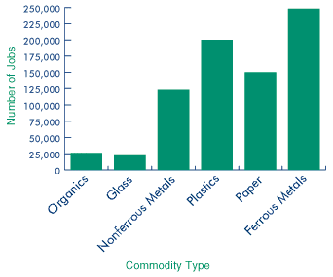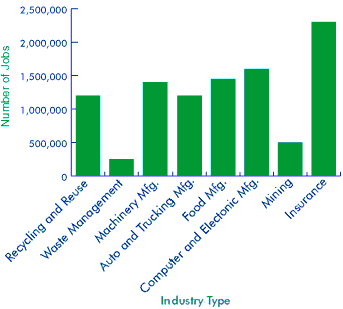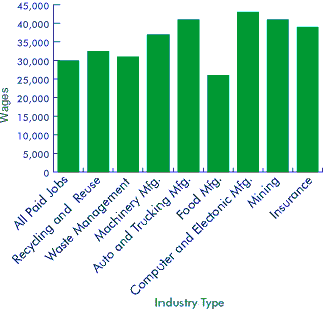
National REI Study
For
a copy of the full report and the executive summary, please download
these PDF files.
|
The National Recycling Economic Information Study reached the following conclusions:
Recycling and Reuse Add Value to the U.S. Economy
Recycling is a Diverse Industry
Recycling is Competitive with Other Major Industries
Local Recycling and Reuse Spur "Downstream" Economic Impacts
Reuse Businesses Contribute Significantly
Recycling and Reuse Add Value to the U.S. Economy
According to the study, the recycling and reuse industry consists of approximately 56,000 establishments that employ over 1.1 million people, generate an annual payroll of nearly $37 billion, and gross over $236 billion in annual revenues. This represents a significant force in the U.S. economy and makes a vital contribution to job creation and economic development.
Estimates
of Direct Economic Activity
Annual Payroll and Estimated Receipts are
in $1,000. Throughput is in
Thousands of Tons. Click for the plain text version of this table">
|
Data Type |
Recycling |
Recycling |
Recycling |
Reuse and |
Industry |
|
Establishments |
9,247 |
12,051 |
8,047 |
26,716 |
56,061 |
|
Employment |
32,010 |
160,865 |
759,746 |
169,183 |
1,121,804 |
|
Annual Payroll |
956,875 |
3,826,360 |
29,181,749 |
2,747,498 |
36,712,482 |
|
Estimated |
1,974,516 |
41,753,902 |
178,390,423 |
14,182,531 |
236,301,371 |
|
Estimated |
191,082 |
191,082 |
157,545 |
N/A |
N/A |
1 Throughput is amount of recovered material recycled and includes manufacturing scrap sent for recycling. It excludes materials prepared for fuel use and in-house process scrap returned to the manufacturing process. Throughput estimates are summed to avoid triple counting at collection, processing, and manufacturing stages.
Recycling is a Diverse Industry
Recycling is an integrated system that starts with curbside collection of materials by municipalities, involves processing of recycled materials, and leads to manufacturing of new products with recycled content. The study identified 26 different types of recycling organizations. The recycling sector includes long-established sectors like paper and steel making, as well as new entrepreneurial ventures such as composting and plastic and rubber product manufacturers. Four major manufacturing industries account for over half of the economic activity of the recycling and reuse industry:
- Recycled paper and paperboard mills, which employ 139,375 people and gross nearly $49 billion in estimated annual receipts;
- Steel mills, which employ 118,544 people and gross $46 billion in estimated annual receipts;
- Recycled plastics converters, which employ 178,700 people and gross nearly $28 billion in estimated annual receipts; and
- Iron
and steel foundries, which employ 126,313 people and gross over $16
billion in annual estimated receipts.
The recycling industry also includes companies that are quickly finding a market niche, including computer demanufacturing, organics composters, and plastic lumber manufacturers.
Recycling
Manufacturing Industry Employment by
Major Material Group

Recycling is Competitive with Other Major Industries
As a driver of economic activity, the recycling industry compares favorably to other key industries, such as automobile manufacturing and mining. Especially significant is the finding that recycling far outpaces the waste management industry because recycling adds value to materials, contributing to a growing labor force. Recycling also provides a large number of jobs that generally pay above the average national wage.
Comparison of Industry Employment

Comparison of Annual Wages per Job

Local Recycling and Reuse Spur "Downstream" Economic Impacts
Investment
in local recycling collection and processing, as well as strong government
policies, spurs significant private sector investment in recycling manufacturing
and promotes economic growth. The study tallied this "indirect"
impact of recycling on support industries, such as accounting firms and
office supply companies, for a total of 1.4 million jobs supported by
the recycling and reuse industry. These jobs have a payroll of $52 billion
and produce $173 billion in receipts.
Spending by employees of the recycling and reuse industry also contributes
indirectly and adds another 1.5 million jobs with a payroll of $41 billion
and produces receipts of $146 billion. The recycling and reuse industry
also generated roughly $12.9 billion in federal, state, and local tax
revenues, with 80 percent going to federal and state government.
Contribution
of Recycling and Reuse to Government
Revenues - Direct Effects Revenues (in $ millions)
|
Industry |
Federal |
State |
Local |
Total |
|
Recycling |
200 |
100 |
100 |
400 |
|
Recycling |
700 |
400 |
300 |
1,400 |
|
Recycling |
5,400 |
2,600 |
2,100 |
10,000 |
|
Reuse/ |
600 |
300 |
200 |
1,200 |
|
Total |
6,900 |
3,400 |
2,600 |
12,900 |
Contribution
of Recycling and Reuse to Government
Revenues - Total Effects Revenues (in $ millions)
|
Industry |
Federal |
State |
Local |
Total |
|
Recycling |
300 |
200 |
100 |
600 |
|
Recycling |
1,700 |
800 |
600 |
3,200 |
|
Recycling |
20,500 |
9,900 |
7,800 |
38,200 |
|
Reuse/ |
2,100 |
1,000 |
800 |
3,900 |
|
Total |
24,600 |
11,900 |
9,400 |
45,800 |
Reuse Businesses Contribute Significantly
The reuse industry is widespread and ranges from more traditional establishments
such as local thrift stores and antique shops to more recent, dynamic
operations such as computer demanufacturers, pallet rebuilders, and materials
exchanges. As a whole, the reuse industry employs nearly 170,000 workers
in more than 26,000 establishments nationwide. The reuse industry also
supports an annual payroll of $2.7 billion and generates revenues of approximately
$14.1 billion.
|
Analysis
of Economic Activity for |
|
|
Establishments |
26,716 |
|
Employment |
169,183 |
|
Annual Payroll |
$2,747,498,000 |
|
Estimated Revenue |
$14,182,531,000 |